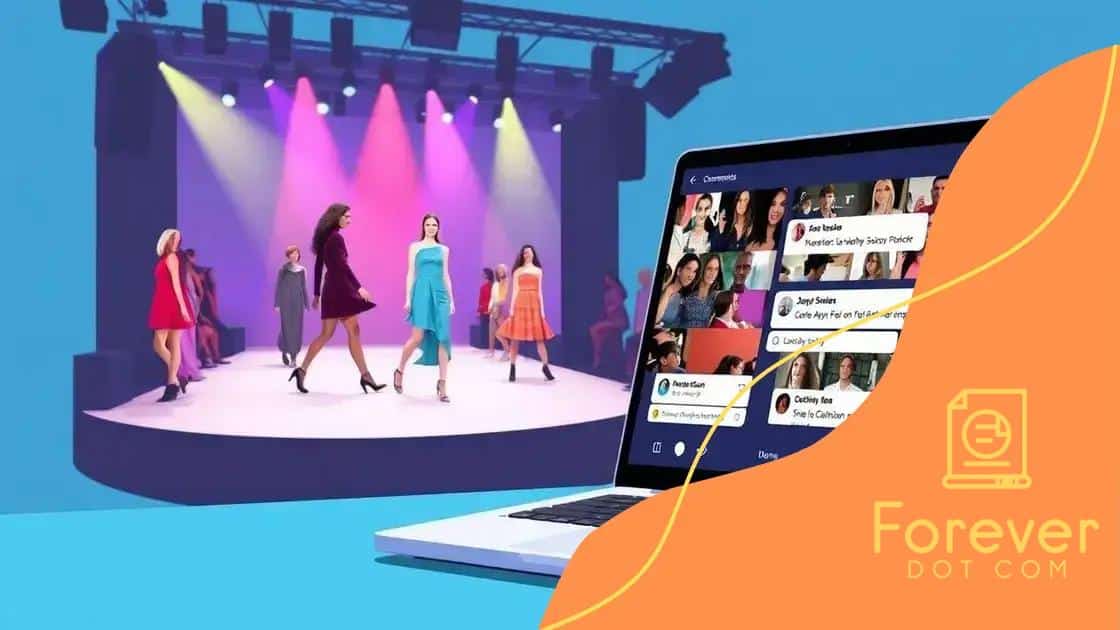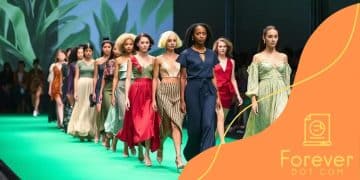How fashion weeks are evolving post-pandemic

How fashion weeks are evolving post-pandemic reflects a significant shift towards inclusivity, sustainability, and the rise of emerging designers, enhancing global engagement and cultural representation in the fashion industry.
How fashion weeks are evolving post-pandemic invites us to explore the dynamic changes shaping these iconic events. With new approaches to showcasing collections, brands are adapting to a world that demands both creativity and connection. Curious about what’s next? Let’s dive in!
The rise of digital fashion shows
The rise of digital fashion shows has transformed the landscape of the fashion industry. With the effects of the pandemic, traditional runway presentations faced challenges, leading brands to seek innovative ways to engage audiences.
Benefits of Digital Fashion Shows
One major advantage of these virtual events is their accessibility. People from around the world can tune in without needing to travel. This inclusivity allows for a broader audience engagement.
- Global reach without geographical constraints
- Increased audience interaction via live chat features
- Cost savings on venue and logistics
- Enhanced creative freedom in presentation
Moreover, digital platforms allow brands to showcase their collections in unique ways. Designers can use technology to create immersive experiences, blending runway presentation with captivating storytelling.
Innovative Features in Digital Shows
Fashion weeks have adopted various technologies such as augmented reality and 3D modeling. This approach allows consumers to visualize garments from their homes.
- Augmented reality features for virtual try-ons
- Interactive videos that enhance the viewing experience
- 3D models providing a 360-degree view of outfits
These innovations not only captivate viewers but also provide valuable insights into consumer preferences through data analytics, helping brands refine their offerings.
As we observe this shift in the fashion industry, it’s clear that digital shows are not just a temporary solution—they represent a new era in how fashion is presented and consumed.
Sustainability in post-pandemic fashion weeks
Sustainability in post-pandemic fashion weeks has become a major focus for brands looking to adapt to a changing world. As consumers become more eco-conscious, the fashion industry is responding with innovative solutions.
Shifts Towards Eco-Friendly Practices
Many designers are prioritizing sustainable materials and ethical production methods. This shift not only helps the environment but also appeals to consumers who value ethical fashion.
- Use of organic fibers and recycled materials
- Reduction of waste through efficient design
- Support for fair labor practices
- Investment in renewable energy for production
Brands are redefining their philosophies, aiming for a circular economy rather than fast fashion. This approach emphasizes recycling and reusing materials, reducing the carbon footprint significantly.
Consumer Demand for Transparency
Today’s consumers are demanding more transparency from brands. They want to know the origins of their clothing and the processes behind their production. As a result, many companies are now sharing detailed information about their supply chains.
- Increased traceability of materials
- Clear communication about sourcing practices
- Transparency in labor conditions
By being open about these processes, brands can build trust with their audience. This connection fosters a loyal following and encourages informed purchasing decisions.
As sustainability continues to be a driving force in the fashion industry, the changes seen in post-pandemic fashion weeks signal a significant shift in how brands operate. This evolution not only benefits the planet but also aligns with the values of modern consumers.
Changing audience dynamics and engagement

Changing audience dynamics and engagement in the fashion industry have shifted dramatically, especially after the pandemic. These changes reflect a deeper connection between brands and their consumers, emphasizing the need for engagement in innovative ways.
Understanding the New Audience
Today’s audiences are more informed and vocal about their preferences. They seek authentic connections with brands and value engagement beyond just transactions. This means brands must adapt their strategies to maintain relevance.
- Focus on community-driven content
- Emphasis on personalization and customized experiences
- Utilization of social media for direct interaction
- Inclusive marketing that represents diverse voices
Brands are utilizing platforms like Instagram and TikTok to connect with younger generations. Through these channels, they can showcase their collections while encouraging audience interaction through comments, shares, and collaborations.
Innovative Engagement Strategies
Brand engagement now involves more than just runway shows. Many brands are hosting live virtual events, allowing audiences to experience the show in real time. These events often include behind-the-scenes content and live Q&As with designers.
- Creating interactive live streams with audience participation
- Offering virtual tours of showrooms
- Incorporating gamification, like virtual fashion challenges
This dynamic approach not only keeps the audience entertained but also fosters a sense of community. It allows fans to feel like they are part of the brand journey. As brands adapt to these new dynamics, their ability to engage meaningfully with the audience becomes a key factor in their success.
Global influences reshaping fashion weeks
Global influences reshaping fashion weeks highlight the interconnected nature of today’s fashion industry. As cultures collide and mix, fashion shows around the world reflect a rich tapestry of styles and ideas.
Cultural Integration in Fashion
Designers increasingly draw inspiration from diverse cultures. This fusion creates unique collections that resonate with global audiences. The authenticity of these designs often stems from a deep respect for the cultures they represent.
- Exploration of traditional patterns and textiles
- Collaboration with artisans from various regions
- Inclusion of diverse fashion icons on the runway
Such collaborations not only enhance creativity but also promote cultural appreciation. They bring stories and heritage to life through contemporary interpretations.
Technology’s Role in Global Fashion
Technology further amplifies these global influences. With social media at their fingertips, designers and brands can share their visions instantly. This accessibility allows trends to emerge from anywhere in the world and reach a global market.
- Real-time feedback from international audiences
- Influence of digital platforms on trend formation
- Cross-border collaborations among designers
Moreover, virtual fashion shows and online marketplaces have made it easier for international designers to showcase their work and connect with consumers. As a result, fashion weeks are no longer limited to geographic locations; they are part of a global conversation.
Fashion weeks are evolving into vibrant celebrations of diversity. By embracing global influences, the industry not only enriches its aesthetics but also connects people from different backgrounds through the universal language of fashion.
Emerging designers and inclusivity
Emerging designers and inclusivity are redefining the fashion landscape in powerful ways. These new talents bring fresh perspectives that challenge traditional norms and promote diversity.
The Rise of New Voices
Emerging designers are gaining recognition for their unique styles and innovative approaches. Many of these creators come from diverse backgrounds, allowing them to share authentic stories through their designs. This enhances the richness of fashion, as it incorporates various cultural influences.
- Focus on underrepresented groups in fashion
- Innovative design concepts that break boundaries
- Use of sustainable materials and ethical practices
Through platforms like social media, these designers can showcase their work to a global audience. This visibility is crucial in a highly competitive industry, giving them the opportunity to share their narratives and gain support from consumers who value inclusivity.
Inclusivity in Fashion Shows
Fashion weeks are increasingly showcasing a wider range of models, reflecting real-world diversity. This shift towards inclusivity is important for representation, allowing people of different sizes, ethnicities, and backgrounds to be seen on the runway.
- Representation of plus-size and gender-neutral models
- Highlighting cultural heritage through fashion
- Creating environments where all voices are heard
By prioritizing inclusivity, brands not only enhance their reputation but also connect more deeply with their audiences. The emphasis on emerging designers fosters an environment where creativity flourishes, and new ideas are welcomed.
As the fashion industry continues to evolve, these trends signify a significant embrace of diversity and innovation, shaping a more inclusive future for all.
FAQ – Frequently Asked Questions about Fashion Week Evolutions
What role do emerging designers play in fashion weeks?
Emerging designers bring fresh ideas and unique perspectives, enriching the runway with diverse styles and stories that reflect global cultures.
How is inclusivity being prioritized in fashion shows?
Fashion shows now showcase a wider range of models, representing various sizes, ethnicities, and backgrounds to foster representation and diversity.
What impact do global influences have on fashion?
Global influences lead to a blend of styles and cultural appreciation, allowing fashion to resonate with a broader audience and reflect interconnected trends.
How are sustainability practices being integrated into fashion weeks?
Brands are now focusing on eco-friendly materials, ethical production, and reducing waste, significantly contributing to sustainability in fashion.






